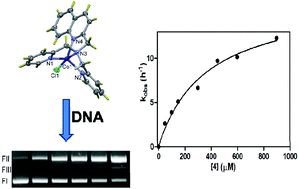Efficient hydrolytic cleavage of plasmid DNA by chloro-cobalt(ii) complexes based on sterically hindered pyridyl tripod tetraamine ligands: synthesis, crystal structure and DNA cleavage†
Abstract
Four new cobalt(II) complexes [Co(6-MeTPA)Cl]ClO4/PF6 (2/2a), [Co(6-Me2TPA)Cl]ClO4/PF6 (3/3a), [Co(BPQA)Cl]ClO4/PF6 (4/4a) and [Co(BQPA)Cl]ClO4/PF6 (5/5a) as well as [Co(TPA)Cl]ClO4 (1) where TPA = tris(2-pyridylmethyl)amine, 6-MeTPA = ((6-methyl-2-pyridyl)methyl)bis(2-pyridylmethyl)amine, 6-Me2TPA = bis(6-methyl-2-pyridyl)methyl)-(2-pyridylmethyl)amine, BPQA = bis(2-pyridylmethyl)-(2-quinolylmethyl)-amine and BQPA = bis(2-quinolylmethyl)-(2-pyridylmethyl)amine were synthesized and structurally characterized. Single crystal X-ray crystallography confirmed the distorted trigonal bipyramidal geometries of complexes 2a–5a. Spectrophotometric titrations and conductivity measurements of the complexes in the CH3CN–H2O mixture showed that the chloro complexes exist in equilibrium with the corresponding hydrolyzed aqua species, [Co(L)(H2O)]2+. The pKa values of the coordinated H2O in aqua complexes vary from 8.4 to 8.7 (37 °C). The interactions of the complexes (1–5) with DNA have been investigated at pH = 7.0 and 9.0 (10 mM Tris-HCl buffer) and 37 °C where very high catalytic cleavage was observed. Under pseudo Michaelis–Menten kinetic conditions, the catalytic rate constants, kcat, decrease in the order 4>2>5>1>3. At pH 7.0 (10 mM Tris-HCl buffer) and 37 °C, the kcat value for complex 4 (6.02 h−1), where [Co(BPQA)(H2O)]2+ is the major species, corresponds to 170 million rate enhancement over the non-catalyzed DNA. Electrophoretic experiments conducted in the presence and absence of radical scavengers (DMSO, KI, NaN3) ruled out the oxidative mechanistic pathway of the reaction and suggested that the hydrolytic mechanism is the preferred one. This finding was in agreement with the observed increase in the kcat values at pH 9.0 compared to the corresponding values at pH 7.0 as a result of the increased concentration of the reactive hydroxo species, [Co(L)(OH)]+. The reactivity of the synthesized complexes in catalyzing the DNA cleavage is discussed in relation to the steric effect imposed by the coordinated pyridyl ligand around the central cobalt(II) center.


 Please wait while we load your content...
Please wait while we load your content...